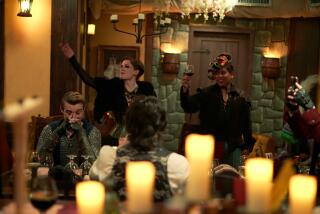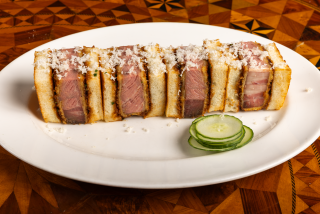Denver Visitors Set Direct Course for Ship Tavern
- Share via
DENVER — Sitting inside the Ship Tavern, it’s hard to tell whether you’re out at sea in an old clipper or down on the waterfront of some old English town. The one place it doesn’t remind you of is landlocked Denver.
For 50 years the Ship Tavern has been a Denver institution, an elegant saloon born in the wood-paneled richness of the Prohibition era. It is, as marine historian Carl Cuttler has noted, a symbol of something fine in a passing civilization.
Behind the mahogany bar are two Jamaican Rum barrels, made by the Staffordshire Potteries in 1830. The mast and crow’s-nest that dominate the snug room are of Oregon fir, the wall paneling of sandblasted chestnut, the linen drapes are hand-blocked screen printed and woven in England. Old pewter is tucked among the alcoves.
It’s No Museum
Don’t get the notion, though, that the Ship Tavern is a museum. This place is utilitarian. It’s a spirited watering hole where Scotch is still the most popular drink, where Michael Murphy plays a fine piano and something called firewater--dried, red peppers in vodka with a Coors chaser--costs $2.
“I was going to order soup or something,” said the man next to me, finishing his firewater, “but I’m not hungry any more. These things are really filling.”
The man said he was from Minnesota and never came to Denver without stopping at the Ship Tavern. In that, he had lots of company, for although about half the saloon’s patrons are locals--a surprisingly high figure considering the establishment is in a hotel, the Brown Palace--almost everyone of note passing through Denver, from actor John Wayne to golfer Ben Hogan, seems to have imbibed at the Ship Tavern at one time or another.
Ford Frick, the late commissioner of baseball, used to get off the plane from New York and head straight to the tavern for a manhattan. Brewer Joseph Coors loved the place although the bartender once served him a Schlitz when he ordered a beer. It was a favorite of California Angels’ owner Gene Autry, too.
Woman Breaks Barrier
We respect people’s privacy, said the captain, Hubie Heid, who worked at the tavern for 37 years and remembers the day a female journalist staged a sit-in at the bar, thus breaking the barrier of what had been an all-male preserve.
The tavern has loosened up since those men-only times when coats and ties were required. But it’s still an upscale saloon, befitting the 231-room Brown Palace itself, which John Gunther referred to in the 1940s as “possibly the best hotel in the United States.” He could well pay it the same compliment today.
Virtually nothing has changed in the prow-shaped tavern since the 1930s when C. K. Boettcher, whose family had recently purchased the hotel, decided to build a saloon to display the collection of sailing ship models he had acquired on a visit to Cape Cod. His wife had left him no choice; she said she didn’t want the models, as splendid as they were, sitting around their home.
So Boettcher turned the architects loose to design a tavern that would reflect music, gaiety, life--an admirable goal, if a bit far-reaching. On opening night, a tipsy sailor shinnied up the 10-foot mast and stayed perched in the crow’s-nest until talked down with the promise of free drinks.
The tavern specializes in Rocky Mountain trout and roast beef from the cart ($10.50). It won my enduring appreciation when I returned to the hotel late one night after a business meeting and told the bartender I had not eaten. He opened up the kitchen for me. I’m sure Boettcher would have had it no other way.
More to Read
Sign up for The Wild
We’ll help you find the best places to hike, bike and run, as well as the perfect silent spots for meditation and yoga.
You may occasionally receive promotional content from the Los Angeles Times.






